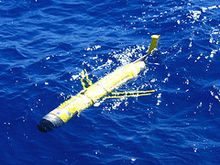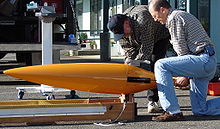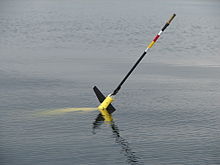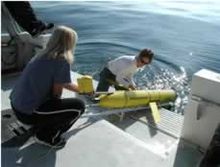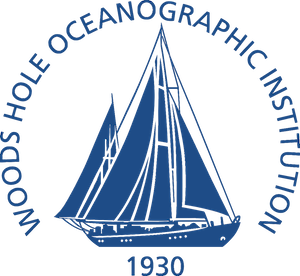
The Woods Hole Oceanographic Institution is a private, nonprofit research and higher education facility dedicated to the study of marine science and engineering.
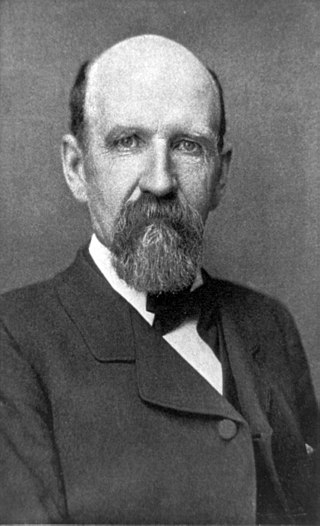
Joshua Slocum was the first person to sail single-handedly around the world. He was a Nova Scotian-born, naturalised American seaman and adventurer, and a noted writer. In 1900 he wrote a book about his journey, Sailing Alone Around the World, which became an international best-seller. He disappeared in November 1909 while aboard his boat, the Spray.

An underwater environment is a environment of, and immersed in, liquid water in a natural or artificial feature, such as an ocean, sea, lake, pond, reservoir, river, canal, or aquifer. Some characteristics of the underwater environment are universal, but many depend on the local situation.

Argo is an international programme for researching the ocean. It uses profiling floats to observe temperature, salinity and currents. Recently it has observed bio-optical properties in the Earth's oceans. It has been operating since the early 2000s. The real-time data it provides support climate and oceanographic research. A special research interest is to quantify the ocean heat content (OHC). The Argo fleet consists of almost 4000 drifting "Argo floats" deployed worldwide. Each float weighs 20–30 kg. In most cases probes drift at a depth of 1000 metres. Experts call this the parking depth. Every 10 days, by changing their buoyancy, they dive to a depth of 2000 metres and then move to the sea-surface. As they move they measure conductivity and temperature profiles as well as pressure. Scientists calculate salinity and density from these measurements. Seawater density is important in determining large-scale motions in the ocean.

An autonomous underwater vehicle (AUV) is a robot that travels underwater without requiring continuous input from an operator. AUVs constitute part of a larger group of undersea systems known as unmanned underwater vehicles, a classification that includes non-autonomous remotely operated underwater vehicles (ROVs) – controlled and powered from the surface by an operator/pilot via an umbilical or using remote control. In military applications an AUV is more often referred to as an unmanned undersea vehicle (UUV). Underwater gliders are a subclass of AUVs.

The Monterey Bay Aquarium Research Institute (MBARI) is a private, non-profit oceanographic research center in Moss Landing, California. MBARI was founded in 1987 by David Packard, and is primarily funded by the David and Lucile Packard Foundation. Christopher Scholin serves as the institute's president and chief executive officer, managing a work force of approximately 220 scientists, engineers, and operations and administrative staff.

Unmanned underwater vehicles (UUV), also known as uncrewed underwater vehicles and underwater drones, are submersible vehicles that can operate underwater without a human occupant. These vehicles may be divided into two categories: remotely operated underwater vehicles (ROUVs) and autonomous underwater vehicles (AUVs). ROUVs are remotely controlled by a human operator. AUVs are automated and operate independently of direct human input.

The Ocean Observatories Initiative (OOI) is a National Science Foundation (NSF) Major Research Facility composed of a network of science-driven ocean observing platforms and sensors in the Atlantic and Pacific Oceans. This networked infrastructure measures physical, chemical, geological, and biological variables from the seafloor to the sea surface and overlying atmosphere, providing an integrated data collection system on coastal, regional and global scales. OOI's goal is to deliver data and data products for a 25-year-plus time period, enabling a better understanding of ocean environments and critical ocean issues.

A drifter is an oceanographic device floating on the surface to investigate ocean currents by tracking location. They can also measure other parameters like sea surface temperature, salinity, barometric pressure, and wave height. Modern drifters are typically tracked by satellite, often GPS. They are sometimes called Lagrangian drifters since the location of the measurements they make moves with the flow. A major user of drifters is NOAA's Global Drifter Program.
SPURV, or Self-Propelled Underwater Research Vehicle, was an Autonomous Underwater Vehicle built in 1957 at the University of Washington's Applied Physics Laboratory. The research and development of this vehicle was funded by the United States Office of Naval Research (ONR), and it became the US Navy’s first autonomous underwater vehicle (AUV). The navy used a total of 7 SPURV vehicles until 1979.
The Seaglider is a deep-diving Autonomous Underwater Vehicle (AUV) designed for missions lasting many months and covering thousands of miles. In military applications the Seaglider is more commonly referred to as an Unmanned Underwater Vehicle (UUV).
Explorer autonomous underwater vehicle (AUV) is a Chinese AUV developed in the People's Republic of China (PRC), first entering service in November 1994. It should not be confused with another two Anglo-American AUVs that share the same name: the American Autonomous Benthic Explorer AUV (ABE) built by Woods Hole Oceanographic Institution, and the British Columbia-based International Submarine Engineering built Canadian Explorer AUV, which is based on its earlier ARCS AUV. Many Chinese AUVs later developed, such as Wukong, WZODA, CR series, Exploration series, Micro Dragon series, Sea Whale series, Submerged Dragon series AUVs, are all based on experienced gained from Explorer AUV.

The Sentry is an autonomous underwater vehicle (AUV) made by the Woods Hole Oceanographic Institution. Sentry is designed to descend to depths of 6,000 metres (20,000 ft) and to carry a range of devices for taking samples, pictures and readings from the deep sea.
The SOLO-TREC is a profiling float that uses a novel thermal recharging engine powered by the natural temperature differences found at different ocean depths to cycle up and down in the ocean. The research and prototype were developed by researchers at the Jet Propulsion Laboratory in Pasadena, CA, and the Scripps Institution of Oceanography in San Diego, CA. The project name stands for "Sounding Oceanographic Lagrangrian Observer Thermal RECharging" vehicle.
Liquid Robotics is an American marine robotics corporation that designs, manufactures and sells the Wave Glider, a wave and solar powered unmanned surface vehicle (USV). The Wave Glider harvests energy from ocean waves for propulsion. With this energy source, Wave Gliders can spend many months at a time at sea, collecting and transmitting ocean data.

Liberdade class blended wing bodies are autonomous underwater gliders developed by the US Navy Office of Naval Research which use a blended wing body hullform to achieve hydrodynamic efficiency. It is an experimental class whose models were originally intended to track quiet diesel electric submarines in littoral waters, move at 1–3 knots and remain on station for up to six months. The "Liberdade" was the name of a ship built by Joshua Slocum prior to the one he single-handedly piloted around the world.

Karen Joy Heywood is a British Antarctic oceanographer and Professor of Physical Oceanography at the University of East Anglia (UEA). She is best known for her work developing autonomous measurements of the Southern Ocean.
CSSC unmanned vehicles (UUV)s are uncrewed vehicles developed in the People's Republic of China (PRC) by China State Shipbuilding Corporation (CSSC), most of which are in service with various Chinese governmental agencies/departments, and government-owned enterprises.

Underwater exploration is the exploration of any underwater environment, either by direct observation by the explorer, or by remote observation and measurement under the direction of the investigators. Systematic, targeted exploration is the most effective method to increase understanding of the ocean and other underwater regions, so they can be effectively managed, conserved, regulated, and their resources discovered, accessed, and used. Less than 10% of the ocean has been mapped in any detail, less has been visually observed, and the total diversity of life and distribution of populations is similarly obscure.
Autonomous Benthic Explorer (ABE) was a pioneering autonomous underwater vehicle (AUV) owned and operated by Woods Hole Oceanographic Institution (WHOI) in Woods Hole, Massachusetts. ABE was designed to perform wide-area seabed surveys at depths of up to 4500m (14,674ft) and completed 222 missions from 1996 until it was lost at sea in 2010. ABE pioneered the use of a relatively simple AUV to perform wide area surveys, identify points of interest, and “scout” for a more sophisticated manned vehicle or ROV.
